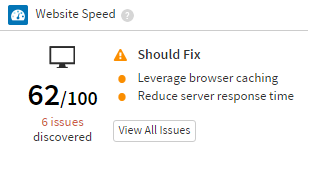
- The Importance Of Rank Tracking Local Keywords In 2018 - June 5, 2018
- How to Spot Opportunities from your Competitors’ Backlinks - July 19, 2017
- Why You Should Monitor Your Brand Daily - May 26, 2017
With the digital age and the mobile evolution comes a new wave of users—those who have a shorter attention span than that of a goldfish. Users lose interest after eight seconds due to all the distractions they see on the web.
As upgrades in mobile devices and the availability of free Wi-Fi seem to show no signs of slowing down, people accessing the web on a daily basis is ever growing. As people are always on the go, the need for faster access to websites becomes a demand that site owners should meet.
Optimizing for website speed is nothing new, but many site owners seem to forget this aspect when developing their websites. While it’s just one of the 200+ ranking signals Google looks at, website speed plays a role in user experience. Every second matters if you want users to stay on your site, or risk them leaving and going to your competitors.
Common Issues that Affect Your Site’s Loading Speed
Before you start optimizing, you need to know where the problem in site speed lies. Here are some of the things you should look into:
- Server reliability and performance – Slow server response time can reduce the loading speed of pages, no matter how optimized they are.
- Heavy files or images – The larger the file, the longer it will take for your site to load.
- Apps and plugins that are not optimized – Extra plugins, widgets, or apps can affect the loading time of your site, as they wait for responses from different servers.
- Ads – Too many ads not only disrupt loading time of the site, but also distract visitors.
- Embedded media – Videos and slideshows can be great sources of content, but they add more codes to web pages, affecting the loading speed of the site.
- Traffic – When traffic exceeds bandwidth limitations, your site may take longer to load.
Resolving Slow Loading Time
A second or two of delay in your site’s loading time can make a world of difference on conversions and user satisfaction. Walmart, for instance, gains 2% increase in conversion for every second they improve their site’s loading speed. The good news is you can do the same.
- Gzip Compression and Deflation
Gzip reduces the file size of web pages and style sheets. Gzipping looks for matching strings within a file to compress—the more matching strings you have, the smaller your files can compress. This makes an effective solution if your network bandwidth is restricted, as well. When a browser makes a request for a page from your site, the server returns the compressed file, which makes transfer time faster. Note that web servers follow different instructions when enabling compression, so make sure you’re implementing the appropriate values.
- Reduced server response time
The ideal timeframe for server response is under 200ms. Many factors can affect your server response time, such as the amount of traffic that goes into your site or the software of your server. Inspect your site’s performance data, so you can identify and resolve bottlenecks.
- Optimized images
Websites will a wall of text are anything but pleasant for users; you still need images to keep your posts interesting. Nonetheless, add images that are in the right file format and size. You can also compress the images to make the file size smaller without compromising their quality. Create templates for images or icons using CSS sprites so they are easier to compress. This also makes them load simultaneously, lessening the waiting time for users.
- Browser caching
One of the most effective ways to ensure site loads faster is by caching. This eliminates the need for the browser to send another HTTP request to your server. Through caching, the site only needs a few elements to load for subsequent visits. Most static resources have a cache lifetime of at least seven days, while ads or widgets have at least a day. You can set an expiry date for some resources, such as CSS files, images, and media files.

A fast website is your ticket to more conversions and higher revenue. By neglecting your website speed performance, you are placing yourself on the bad side of users and search engines. Regular monitoring can provide you insights on how to improve your website speed—this is where Siteoscope comes in.
Our streamlined dashboard features your speed score for both the desktop and mobile versions of your site. We also provide the issues that require fixing and a list of priorities when optimizing for enhanced website speed.
Don’t let your visitors wait with poor website performance. Create your Siteoscope account today and see how our website performance tracking tool works.

